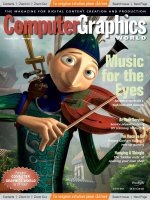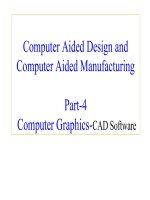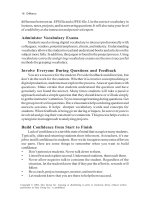Interactive Computer Graphics docx
Bạn đang xem bản rút gọn của tài liệu. Xem và tải ngay bản đầy đủ của tài liệu tại đây (1 MB, 30 trang )
Interactive Graphics Lecture 18: Slide 1
Interactive Computer Graphics
Lecture 18
Kinematics and Animation
Interactive Graphics Lecture 18: Slide 2
Animation of 3D models
In the early days physical
models were altered frame
by frame to create animation
- eg King Kong 1933.
Computer support systems
for animation began to
appear in the late 1970, and
the first computer generated
3D animated full length film
was Toy Story (1995).
Interactive Graphics Lecture 18: Slide 3
Computer Aids to Animation
Fully automatic animation has not proved successful.
However computer tools to support animation have
developed rapidly.
These remove much of the tedious work of the
animator, and allow the creation of spectacular special
effects. Basic Approaches are:
Physical Models
Procedural Methods
Keyframing
Interactive Graphics Lecture 18: Slide 4
Physical Modelling
This approach is suitable for inanimate objects or
effects where there is a simple physical model:
Bouncing balls
Cars on rough roads
Effects can be created by Newtonian mechanics
In some cases composite models can be applied
Spring mass damper arrays for fluttering flags
Particle systems for fire smoke etc.
Interactive Graphics Lecture 18: Slide 5
Procedural Approach
The behaviour of an object is described by a procedure,
sometimes specified by a script.
This kind of approach is appropriate for well known
behaviours in inanimate objects:
eg crack propagation in glass or concrete which is
difficult to model physically but easy to describe
procedurally.
Interactive Graphics Lecture 18: Slide 6
Keyframe Approach
Animators specify two positions of the skeleton
(keyframes) a short time apart. The computer then
calculates a number of “in between” positions to effect
a smooth movement between the two keyframes.
This was a traditional method in hand drawn animation
where the senior animator drew the key frames and
some stooge would then laboriously draw all the in
betweens.
Interactive Graphics Lecture 18: Slide 7
Creating In-betweens
The in-betweens are created by interpolation.
For certain objects they can be created by using paths
of motion defined by, for example, spline curves.
However there are difficulties:
Observing the laws of physics
Making plausible movements
Interactive Graphics Lecture 18: Slide 8
Movement Control
When animating vital characters any model animation
must be kept plausible. Hence computer systems are
often based on jointed skeletons.
Each link in the articulated
chain is rigid. The movement
is constrained by the degree
of freedom at each joint.
The skeleton can be fleshed
out in any way.
Interactive Graphics Lecture 18: Slide 9
Luxo Jr. (1987)
This award winning short film was the hailed as the
first example of computer generated 3D animation that
was as natural as hand crafted animation.
It was based on the use of an articulated skeleton.
/>Interactive Graphics Lecture 18: Slide 10
Complexities of Natural Motion
Natural motions are
complex, as shown by
Eadweard Muybridge's
horse photographs (1878).
Some systematic approach
is needed for “scripting”
the motion of the skeleton.
Interactive Graphics Lecture 18: Slide 11
Motion Capture
One approach to defining the
movement is to use motion
capture - for example Gollum in
the Lord of the Rings films.
These methods require
laborious data capture and are
surprisingly hard to automate.
Interactive Graphics Lecture 18: Slide 12
Motion Capture
King Kong (2005) also used motion capture.
The actor wore a blue suit and was marked with around
80 identifiable spots that could be tracked by cameras.
The spots were mapped (not linearly) to corresponding
points on the computer Kong model.
The actor had to study gorillas and then imitate their
movements.
Interactive Graphics Lecture 18: Slide 13
Kinematics
Although natural skeletons are not
strictly rigid, it is a good
approximation to treat them as such
and thus constrain the movement.
The study of the movement of
articulated chains began in
mechanical engineering of robots and
is called kinematics.
Hip
Knee
Ankle
Thigh
Shin
Foot
Interactive Graphics Lecture 18: Slide 14
Degrees of freedom
Hinge Joint - One degree of freedom
Knee or elbow joint
Saddle - Two degrees of freedom
Wrist/Hand joints
Socket Joint - Three degrees of freedom
Hip, shoulder neck
Images from www.shockfamily.net
Interactive Graphics Lecture 18: Slide 15
Euler Angles
At any joint we can specify the orientation of one link
relative to the other by the Euler angles. These encode
pitch, roll and yaw.
The links are fixed in length (rigid), so the position of
end of the chain is completely defined by a set of Euler
angles.
For the leg we have 3(hip) + 1(knee) + 1 (ankle) = 5
variables (Euler Angles) to determine the end point.
Interactive Graphics Lecture 18: Slide 16
Euler Angles
Euler was the first mathematician to prove that any
rotation of 3D space could be achieved by three
independent rotations.
There is no standard way of achieving this, but the
usual convention is to:
1. Rotate about Z
2. Rotate about X
3. Rotate about Z
The complete Euler rotation matrix R
E
is therefore:
Interactive Graphics Lecture 18: Slide 17
Euler Angles
This formulation is not very intuitive, so to see what is
happening consider transforming a vector w lying
along the z axis.
The first rotation will not change w but turns the u and
v directions about the w. The second matrix can
rotate w to point to any position in the y-z plane.
w
Z
Z
w
Y Y
Interactive Graphics Lecture 18: Slide 18
Euler Angles
The last rotation about the z axis can make the
projection of w point in any direction in the x-y plane.
Looking from the positive z axis we have:
So the last two rotations can orient w in any
direction in the 3D space.
w
X
Y
w
X
Y
Interactive Graphics Lecture 18: Slide 19
Euler Angles
The first rotation turns the u and v directions about the
w. This would be equivalent to a roll, or the rotation of
an image about its centre if w were the viewing
direction.
Thus the specifying the three Euler angles allows us to
rotate a (u,v,w) axis system to any orientation we
require, while preserving its orthogonality.
Interactive Graphics Lecture 18: Slide 20
Forward Kinematics
Forward kinematics is used in robot control. Given a
specification of the Euler angles of each joint or an
articulated robot arm we calculate the position and
orientation of its end point.
This is a well posed problem and can be solved by
matrix transformations of space similar to the ones that
we have already seen in use - for example in first
person shoot 'em ups.
Interactive Graphics Lecture 18: Slide 21
Forward Kinematics Computation
We define a coordinate system at the start of a chain and at
each joint.
Each new coordinate system is defined in the co-ordinate
system of the previous joint.
Thus the position C
i
and the
direction vectors {u
i
, v
i
, w
i
}
of frame i are defined using
the frame i-1 coordinate
system.
u
i
w
i
v
i
Link i-1
Frame i-1
Link i
Frame i
Interactive Graphics Lecture 18: Slide 22
Forward Kinematics Computation
The position C
i
and the direction vectors {u
i
, v
i
, w
i
} of each
frame can be calculated simply using the Euler rotation
matrix R
E
: u
i
= [1,0,0]R
E
, v
i
= [0,1,0]R
E
, w
i
= [0,0,1]R
E
and
C
i
= [0,0,L
i-1
]R
E
where L
i-1
is the length of link (i-1).
We can express positions
and directions in frame i in
the coordinate system of
frame i-1 by a matrix
transformation, which is the
inverse of the viewing
transformation discussed
earlier in the course.
u
i
w
i
v
i
Link i-1
Frame i-1
Link i
Frame i
Interactive Graphics Lecture 18: Slide 23
Revision - the viewing transformation
To transform the scene coordinates to the axis system
{u,v,w} system (using pre-multiplication) we used:
Y
X
Z
v
u
w
C
Y
X
Z
Interactive Graphics Lecture 18: Slide 24
Revision - Viewing transformation
The inverse of the viewing transformation (which we need
for forward kinematics) can be written as:
which can be verified by multiplying out:
Interactive Graphics Lecture 18: Slide 25
Forward Kinematics Computation
If we denote the transformation from the i
th
to
the i-1
th
frame as:
Then the complete forward transformation (using pre-
multiplication) can be seen to be:









